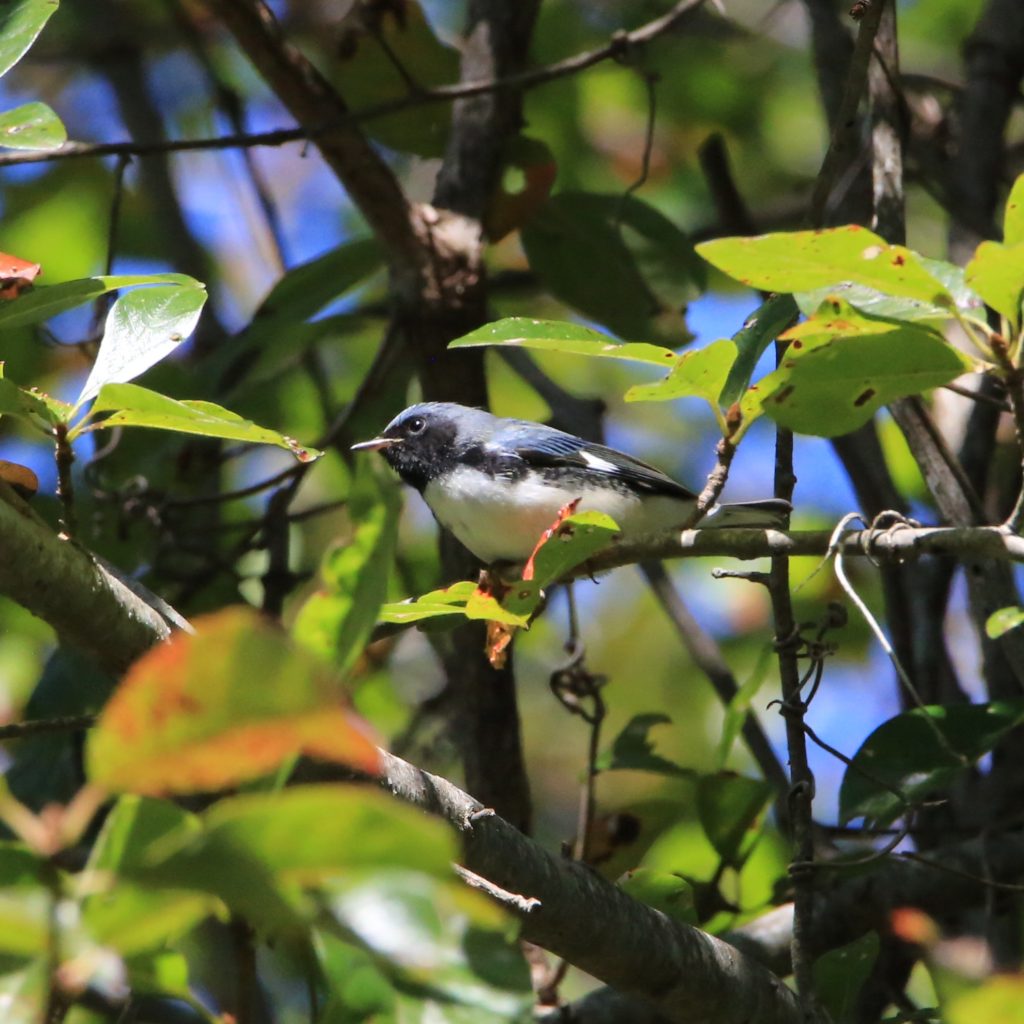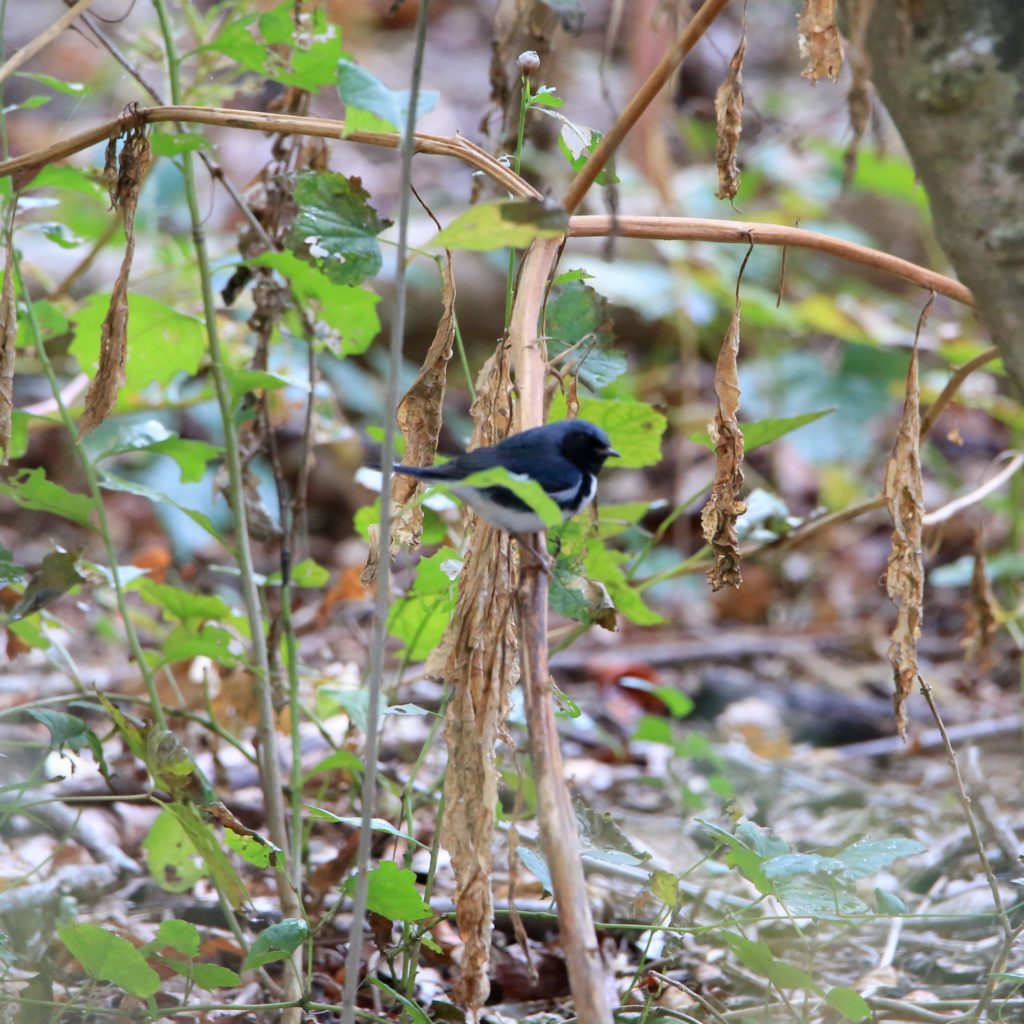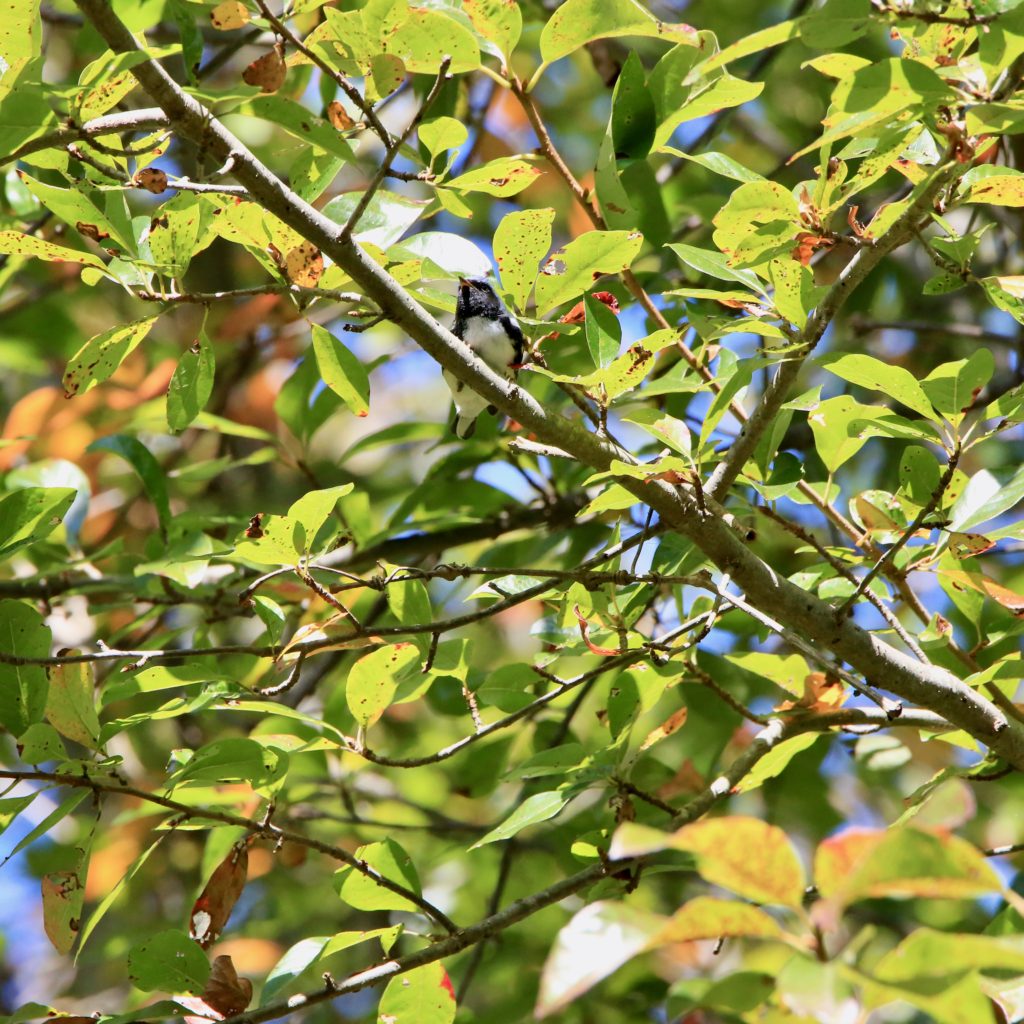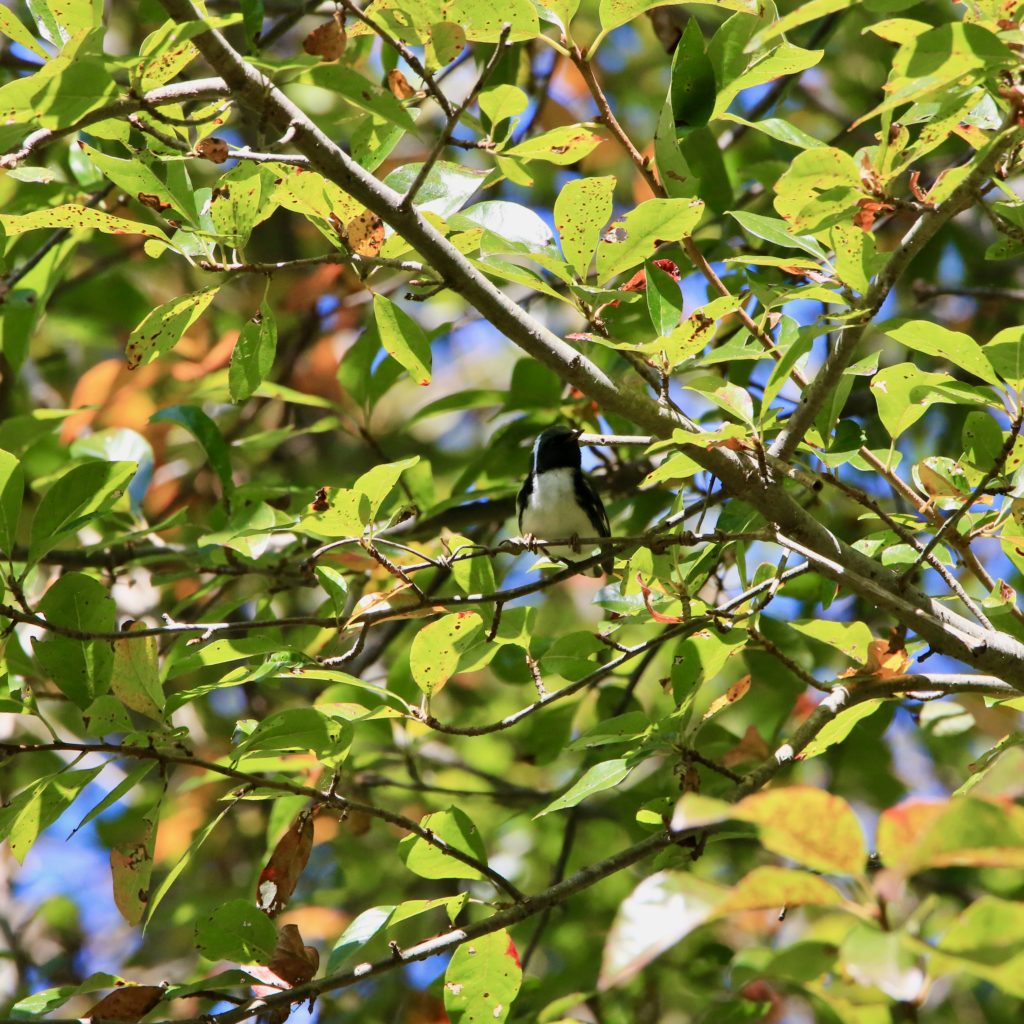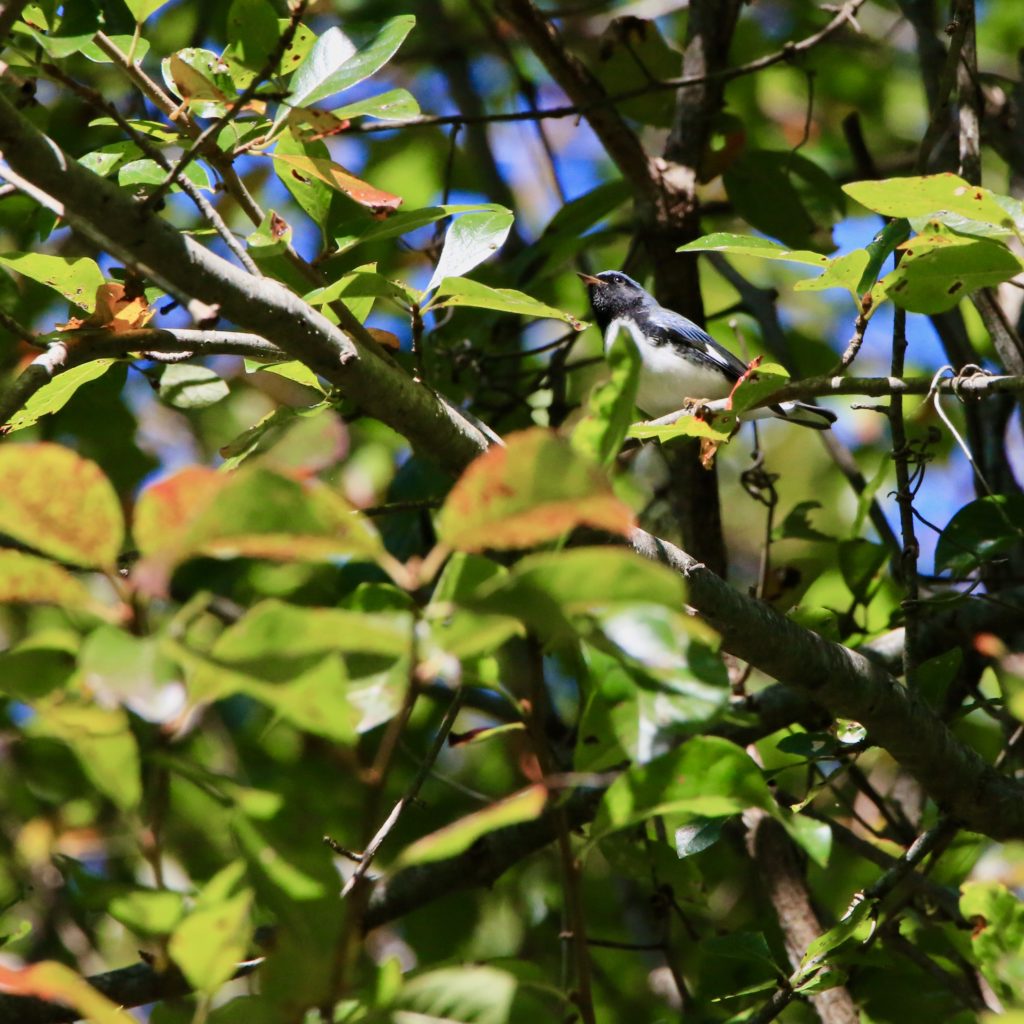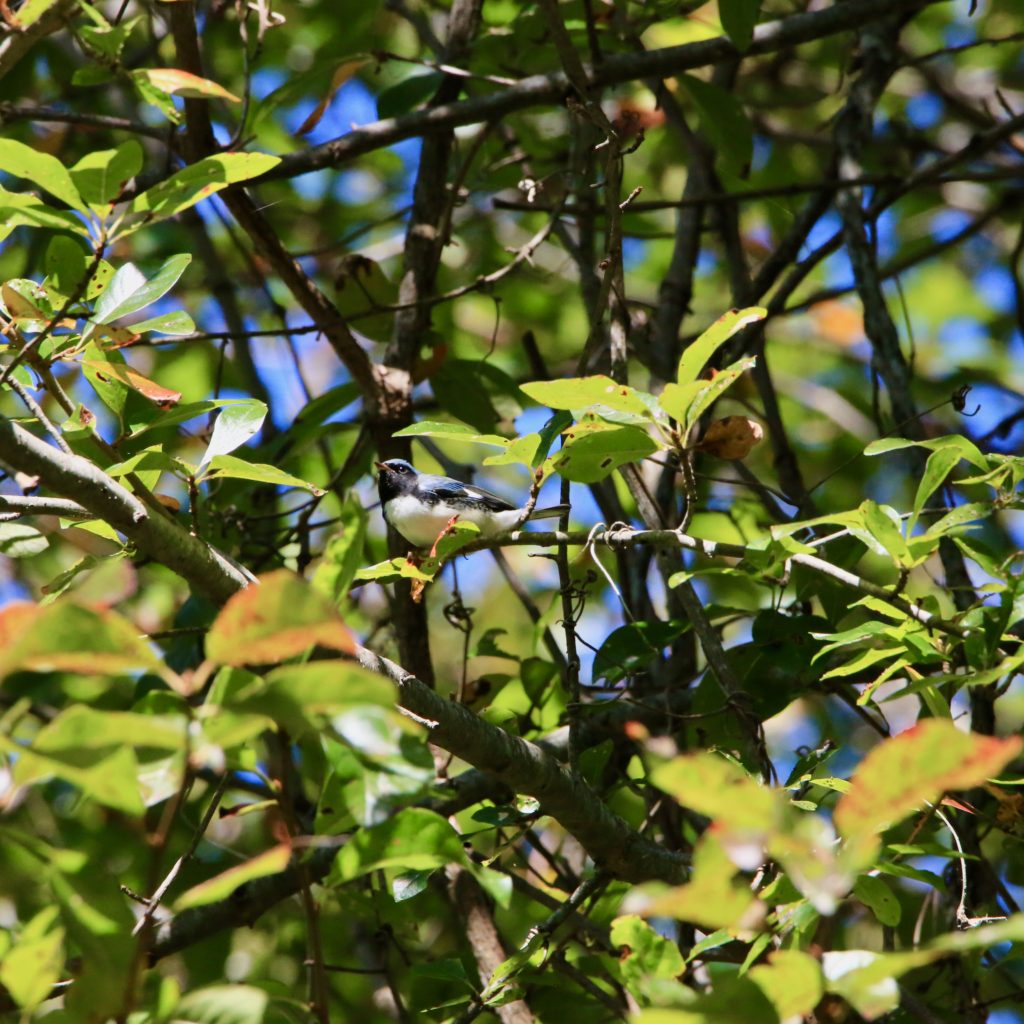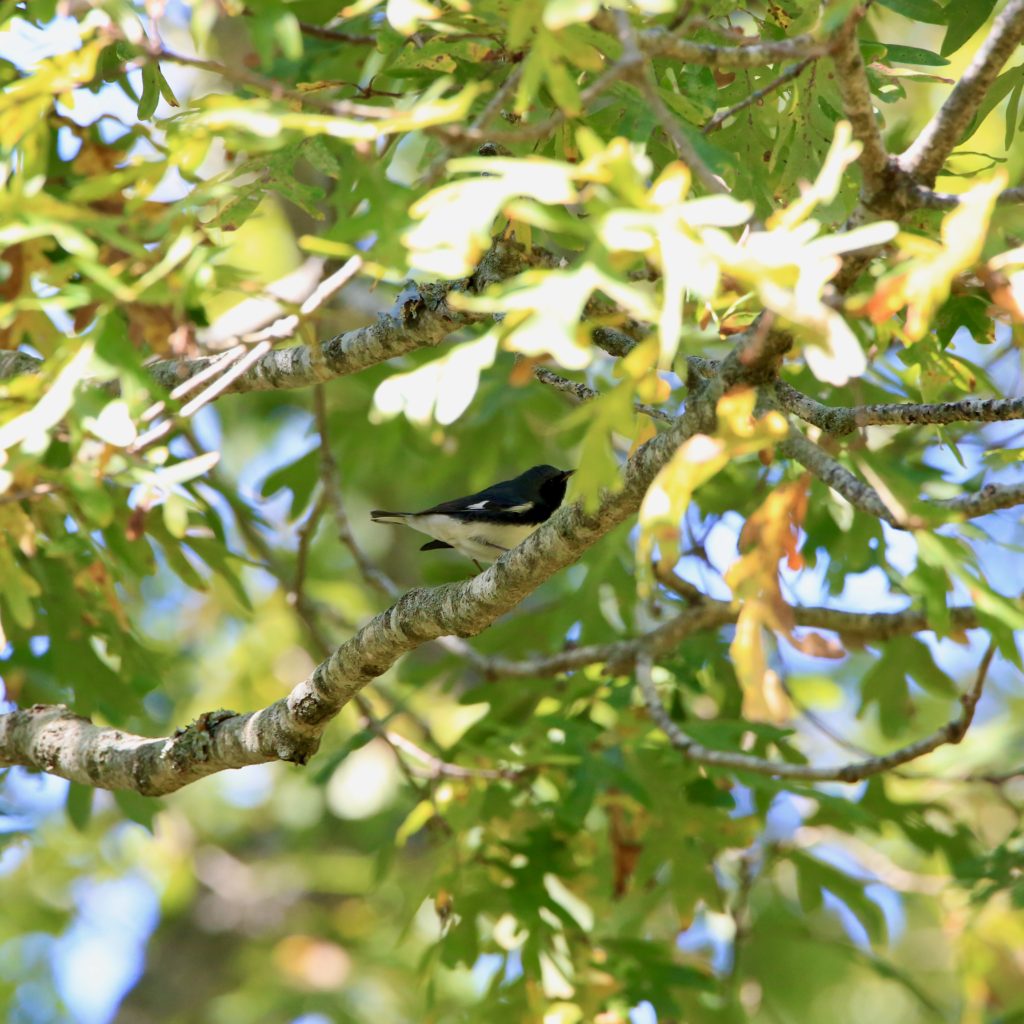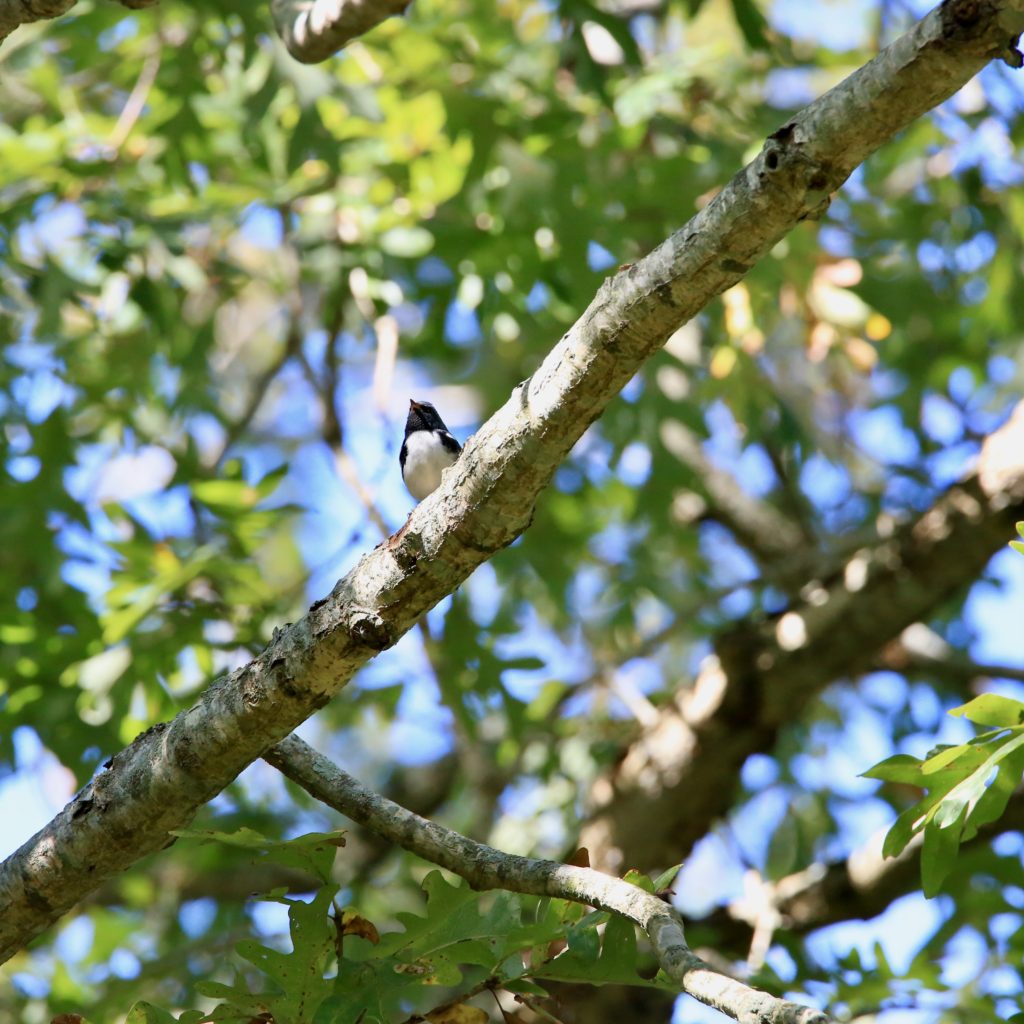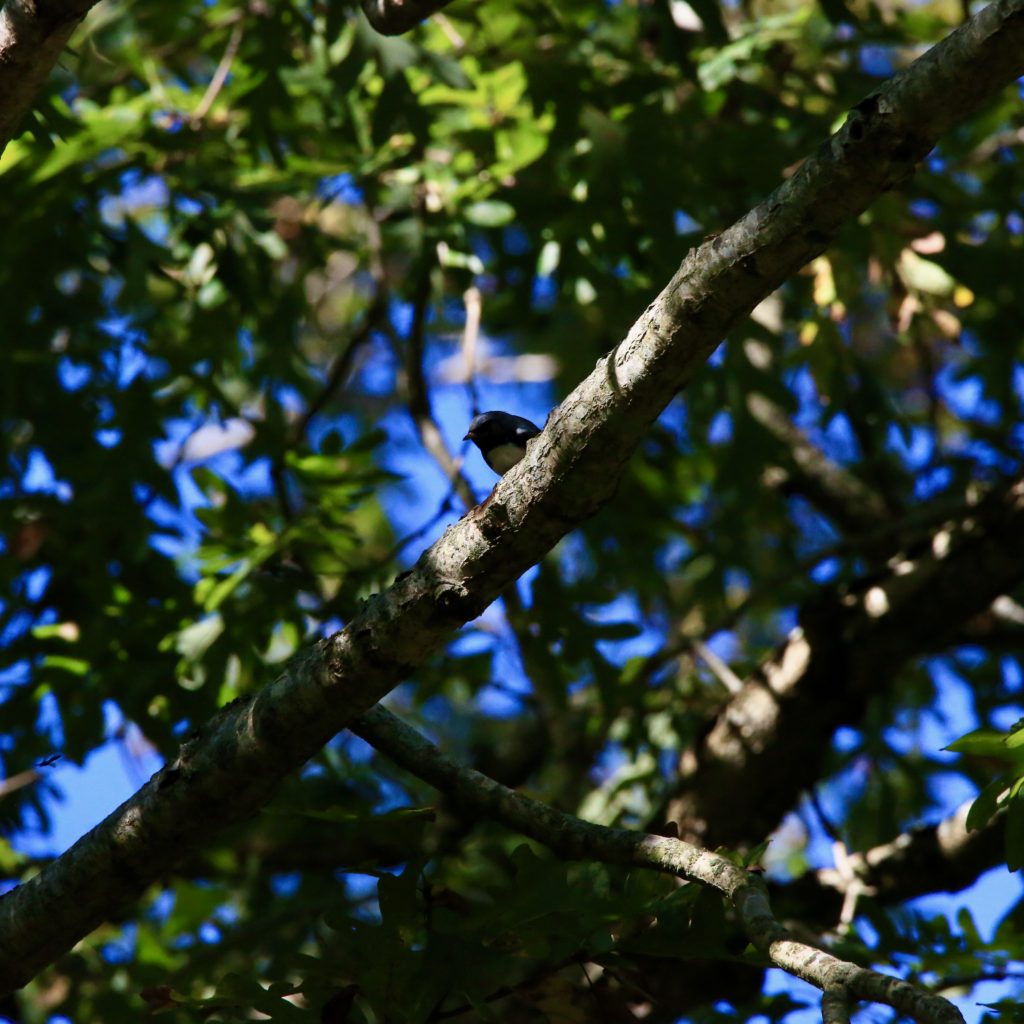
Black-throated Blue Warbler
A Black-throated Blue Warbler is a fun bird to see while bird watching. Below are some tips to help you identify Black-throated Blue Warblers. We have also put together a list of fun Black-throated Blue Warbler t-shirts, Black-throated Blue Warbler bird patches, bird houses, bird feeders, binoculars, stickers and other fun bird watching items.
About Black-throated Blue Warblers
The Black-Throated Blue Warbler is a small bird of the New World warbler family. It lives and breeds in mixed forests in the eastern parts of North America. They migrate to the Caribbean and Central America during the cooler months of winter. Their numbers have undoubtedly declined in some areas. Although the exact reason for declining are still sketchy, it is attributed to the continuous loss of habitat in winter and summer.
Passerine in nature, Black-throated Blue Warblers also belong to the New World Warbler family. In eastern North America, the breeding range consists of mixed coniferous forests and deciduous forests. In winter, one can find them in the Caribbean and Central America.
Interestingly, the Black-throated Blue Warblers’ visual identification changes drastically depending on whether it is male or female. The male Black-throated Blue Warblers, just like its name, has shades of deep blue and black all over them.
The female Black-throated Blue Warblers possess a much duller color than one would assume from the name. This species has also been on the decline for a while. It is primarily due to its need for large forest spaces, which seem to be growing less and less every day.
Today, we will learn more about them. This will include:
- Black-throated Blue Warblers color, identification, size
- Black-throated Blue Warblers anatomy, behavior, habitat
- Black-throated Blue Warblers lifecycle and range and migration
Description and Identification
The best way to identify a Black-throated Blue Warbler lies in noticing its color patterns. The male Black-throated Blue Warblers are mostly impossible to ignore. Their entire blue back, combined with their black face and throat, makes them stand out in between the forest’s greenery.
Of course, the white of the stomach also makes the color stand out. The female Black-throated Blue Warblers are much more forgettable. Their color doesn’t stand out, so you might misidentify them easily. They have mostly grey olive color all over their plumage.
Their wings have some of the black colors in them. However, the distinct white on their feathers does help them stand out. Sometimes, they might also have the blue color associated with Black-throated Blue Warblers, making them easier to find.
The song of the Black-throated Blue Warblers is another way to identify them. Few bird species have the lazy drawl in their songs or the trill sound that makes it pleasant to the years. The notes Black-throated Blue Warblers produce are much pleasing to the year compared to other warblers.
Of course, you need to remember what their body should be like as well. The Black-throated Blue Warblers primarily have the body type of most warblers. It is a mix of a plump shoulder, stomach, and back area with a small head and non-existent neck. The proportions are quite pleasing to look at.
Black-throated Blue Warbler Color Pattern
The color patterns on Black-throated Blue Warblers are so distinctive that you can’t ignore them if you see them. Well, especially if you see male Black-throated Blue Warblers. They have a plump body that can showcase all the colors.
The male Black-throated Blue Warblers’ face and throat are black with deep blue on their back and the top of their head. Yet, the stomach area is entirely white. The tail feathers have a mixture of black and blue. The wings are striped with black though it starts with the blue color first.
The female Black-throated Blue Warblers have an almost dull shade. It is mainly olive color that verges on gray all over their body. There might be the slightest bit of blue on the wings and tail.
On the wings, there is a square-shaped white spot, which is the one thing that helps distinguish them. This white color on the wings of both male and female Black-throated Blue Warblers are called pocket-handkerchiefs.
The black male has a black face and cheek with deep blue underparts, upperparts and a white belly contrary to the female. The female is olive-brown on top and light yellow on her lower side. They have a colorful plumage during winter and summer.
Black-throated Blue Warbler Song
Mostly, it is the Black-throated Blue Warblers that we find to be singing. The female warblers do sing from time to time. The notes are a 3 to 7, with a buzzing quality to them.
The song begins quite slowly and ends on a slurry blur. Rumors have it they are saying, “I am so lazy.” Another thing, they are pleading by literally saying please, please. The song also has a clearer-version, with five notes rising and then falling swiftly. Then, it rises again with a buzz.
During the breeding season, one can find male Black-throated Blue Warblers singing this song from where they are perched on either the middle or lower level of the forest. They do so to attract potential mates. There is also another song. This one has a 2 to 6 buzzy note, with the pitch rising at the very end.
The second type of song is sung by male Black-throated Blue Warblers when they want to protect their territory or have met an aggressive bird they want to fight. The call might be the simplest one. It is a smacking sound that happens once, and then it is over. Both male and female Black-throated Blue Warblers do the call.
Black-throated Blue Warbler Size
The Black-throated Blue Warbler is fairly a small bird and measures just 13cm in length. It weighs about 10g and has a wingspan of 8-12cm to support its flight.
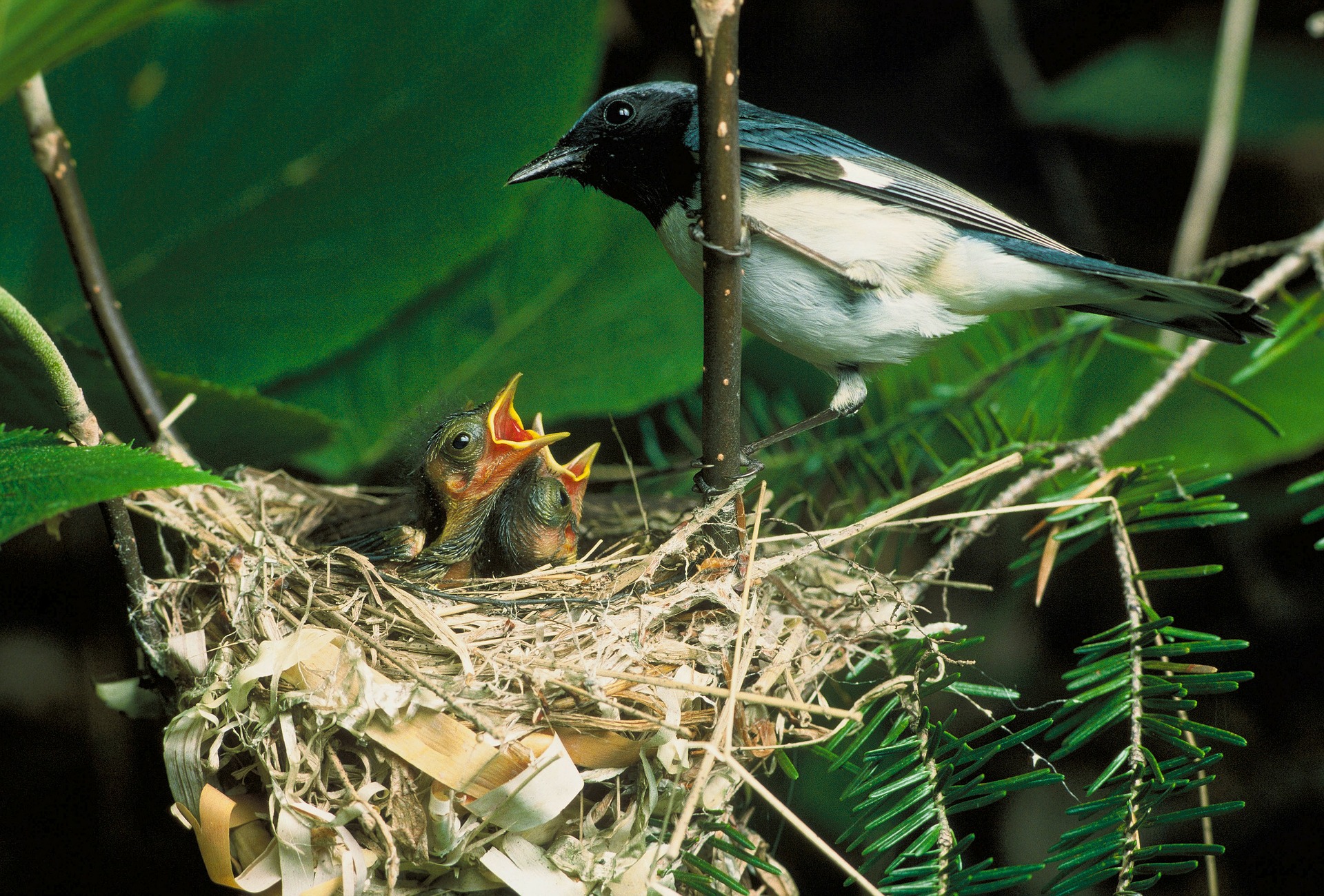
Like most warblers, Black-throated Blue Warblers are on the small side. They have an excellent body proportion with bills best described as sharp and pointy. Even so, if you compare them with the size of other warblers, Black-throated Blue Warblers might be considered large. They have a plump body with a well-adjusted head.
Black-throated Blue Warblers are smaller in comparison to Hermit Thrush. Yet, they are bigger compared to Blue-gray Gnatcatcher. The length is like all medium-sized warbler, somewhere between 11 cm to 13 cm.
The weight ranges generously from 8 g to 12 g. The wingspan might be a bit shorter than other warblers of the same size, about 19 cm to 20 cm.
Black-throated Blue Warbler Behavior
The Black-throated Blue Warblers are seen in the low canopy areas of forests or the understory of trees, foraging food. They pick out insects resting on the underside of the leaves. When they are breeding, they might sing to defend the territory they have established.
They also sing while they are trying to chase away other males encroaching on their territory. Black-throated Blue Warblers also have a more systematic approach to foraging.
They look thoroughly in the understories and the trees at a lower level. They forage by picking out insects that are in the foliages, or they might hover around the leaves until they spot an insect they can take.
In summer, one can see male Black-throated Blue Warblers foraging higher compared to female ones. Sometimes, they steal insects caught up in spiderwebs. During migration, they might join mixed flocks of other birds. During winter, they establish a feeding territory of their own and have no problem chasing away anyone who might try to enter.
The bird sings in a relaxed manner over warm summer mornings. The song sounds buzzy and in an I-am-so-la-zee tune. During winter, the male and female prefer different grounds. For those who are bird watching, the male can be seen in lower to middle elevations of the forest while the female will be seen in shrubbier higher elevations.
What Black-throated Blue Warbler Eat
Again, like most warblers, Black-throated Blue Warblers’ entire diet is dependant on insects. Summer especially sees them feasting on insects, from caterpillars to spiders, moths, flies, etc.
The insect diet continues well into winter, but they might add in some seeds, small fruits, etc., to the mix to make the winter months tolerable. They might even drink nectar from flowers. Sometimes, they are seen on feeders of Hummingbird so that they can taste the sugary water.
Over at the Dominican Republic, the bird takes advantage of the sweet treat of insects harvesting tree sap. The insects harvest the sap and secret it on their backs which the Black-throated Blue Warbler drinks. They also feed on caterpillars, moths, crane flies and spiders. In winter, they take on seeds, small fruit, and flower nectar.
Where Black-throated Blue Warblers Live and Their Habitat
Black-throated Blue Warblers are seen in large tracts made of Hardwood and even in mixed hardwood combined with evergreen forests where the understory is shrubby.
They need the forest space they inhabit to be continuous. If it is not, these warblers tend to lose sight of their habitat, which can be quite hard for them.
The birds live in the interior of hardwood and mixed deciduous-coniferous forests. They like breeding in large areas of unscaled forests of birch, maple, beech, spruce, eastern hemlock, and fir. It likes dense and shrubby areas during winter while it inhabits dense tropical woods during summer.
Range and Migration
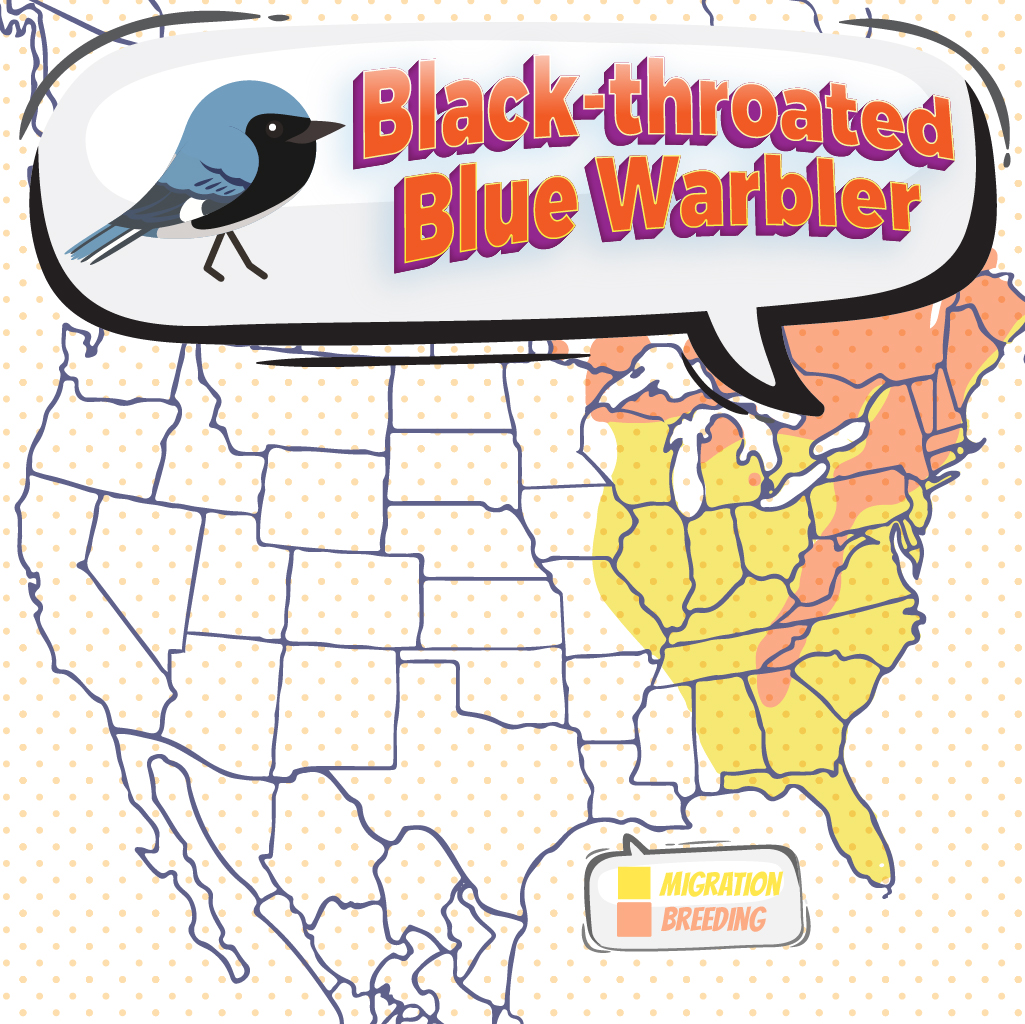
Black-throated Blue Warblers can be long-distance migrants. They do stick to a more medium flight schedule for the most part. At night, they migrate to the Bahamas, the Greater Antilles.
Occasionally, they might end up in Central America or Mexico’s Caribbean coast. Their usual breeding range is the mixed forests and deciduous forests. It is usually in the east part of North America.
One can also see them in the southeast of Canada. During late summer, they are found in the tropical woods. During Winter, we can find them in the Greater Antilles.
Black-throated Blue Warbler Lifecycle
The broods consist of four eggs. Sometimes, the egg count can be as low as two or as much as 5. Usually, the eggs are creamy white. At the ends, there might be gray or brown splashes.
Only the female Black-throated Blue Warblers participate in incubation, which might go on for 12 to 13 days. These are some of the few warblers safe from cobweb parasitizing them. This possibly is because they make their nests in the deeper interior of the forests.
Both parents take part in feeding their youngins. After 8 to 10 days, it seems as if the young Black-throated Blue Warblers are ready to leave their nests. At this stage, though, they are not the best flyers. They can hop around from branches to branches, though.
Often, it is the male Black-throated Blue Warblers that take care of the fledging. The female might be already on its 2 or 3 nests. During the last brood of the season, it might be the female Black-throated Blue Warblers who becomes the provider instead.
The female lays 2-5 eggs during their brooding period. The eggs are incubated for 12-13 days after which they hatch. The young then leave the nest 8-12 days after they have hatched. They have a lifespan of about 10 years.
Nesting
Among the warblers, Black-throated Blue Warblers belong among the few who are not purely monogamous. The male Black-throated Blue Warblers have the possibility of having more than one partner.
In between seasons, though, the pairs stay faithful to each other. Almost 80 percent of the birds who return will go back to the mate they previously paired up with.
For the nest site, they choose thick shrubs. Viburnum, laurel, etc., are their preferred shrubs. Sometimes, they will make a nest on a sapling. Usually, it would be within 6’ distance from the ground. They use dead branches so the nests can get more support.
It is the female Black-throated Blue Warblers who make the nest while the male ones act as support. The nest is something of an open cup, with plant fiber, cobwebs, bark strips, etc. Then they line the nests using hair, moss, needles.
Anatomy of a Black-throated Blue Warbler
The legs of a Black-throated Blue Warbler are thin. However, it still has some substance to it compared to most warbler species. They also tend to have a round, plump body. Their tails are long, though shorter compared to other warblers of the same size.
The wingspan is also considered shorter if we compared them to other warblers. Their body is relatively proportioned overall, though. The head is round like the stomach area. The neck and head meet at a point where it is impossible to differentiate one from the other.
Black-throated Blue Warblers have large black eyes, though beady. Their bills are thick and long and appear to be in a straight line.
Final Thoughts
Black-throated Blue Warblers are among the warblers who require large forest space. They need the forest to be continuous for their nesting to be successful, so it has become quite challenging for the warblers to survive in some areas.
The loss of habitat in wintering and summer ranges has also made them way more vulnerable than they used to be. So, while it is possible to come across a Black-throated Blue Warbler, it is harder than it used to be.
Amongst the eastern woods filled with leafy trees, the lazy drawling song of the Black-throated Blue Warblers comes from the understory of trees. This species keeps to themselves. However, they are not shy by any means.
If you are a birdwatcher who can maintain the quiet while walking through the trail, you will be able to see them and even take some pictures. When they are searching for insects, they tend to be quite active.
They don’t seem to move fast from the area they are foraging, though, unlike other warblers, who chase down the whole area in one go. It will give you more opportunities to come across Black-throated Blue Warblers at a single place if you stay put near their foraging area.
So, bring out your binoculars and camera and take a trip to the deciduous forests closest to you. Chances are, you will come across some of the members of this famous species.
Ornithology
Bird Watching Academy & Camp Subscription Boxes
At Bird Watching Academy & Camp we help kids, youth, and adults get excited and involved in bird watching. We have several monthly subscription boxes that you can subscribe to. Our monthly subscription boxes help kids, youth, and adults learn about birds, bird watching, and bird conservation.
Bird Watching Binoculars for Identifying Black-throated Blue Warblers
The most common types of bird watching binoculars for viewing Black-throated Blue Warblers are 8×21 binoculars and 10×42 binoculars. Bird Watching Academy & Camp sells really nice 8×21 binoculars and 10×42 binoculars. You can view and purchase them here.
Black-throated Blue Warbler T-shirts
If you love the Black-throated Blue Warbler you should purchase a Bird Watching Academy & Camp T-shirt. To help support bird conservation we donate 10 percent to bird conservation activities.
Black-throated Blue Warbler Iron On Patches
Kids, Youth, and Adults love to collect our Bird Watching Academy & Camp iron on patches. Our bird watching patches help you keep track of the birds you have seen an identified. You can also display the patches on our Bird Watching Academy & Camp banners.
The Black-throated Blue Warbler is a great iron on patch to start your collection with. The patches are durable and can be sewn on or ironed on to just about anything.
Black-throated Blue Warbler Stickers
Stickers are a great way for you to display your love for bird watching and the Black-throated Blue Warbler. We sell a monthly subscription sticker pack. The sticker packs have 12 bird stickers. These sticker packs will help your kids learn new birds every month.
Bird Feeders For Black-throated Blue Warbler
There are many types of bird feeders. Here are our favorite bird feeders for your backyard. We use all of these bird feeders currently. Kids will have a great time watching birds eat at these bird feeders. Using this collection of bird feeders will provide a wide variety and many types of birds.
Best Bird Houses for Black-throated Blue Warbler
There are many types of bird houses. Building a bird house is always fun but can be frustrating. These 4 bird houses have become our favorites. Getting a bird house for kids to watch birds grow is always fun. We spent a little extra money on these bird houses but they have been worth the higher price and look great.


